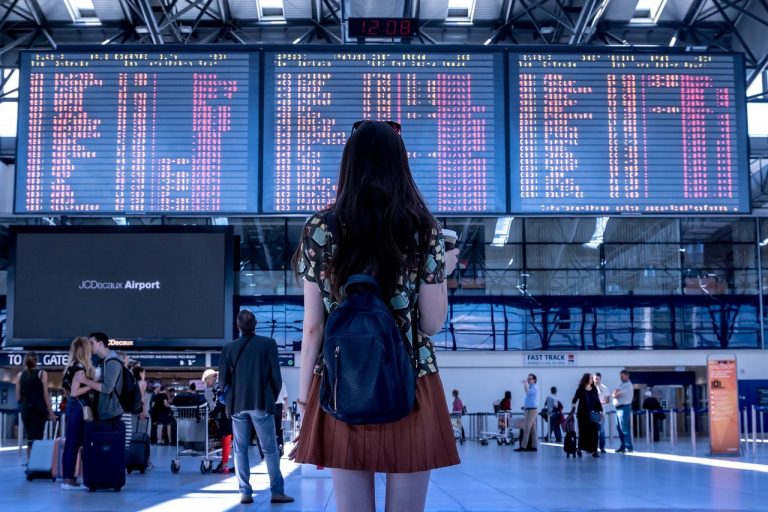Travelling in a Bus With Your Baby – Precautions to Take
For many of us, public transport might be an inevitable part of life. Whether it is the rickshaw, the metro, or the bus, scores of things can go wrong if you are not well-prepared. First, you need to get to know the timetable; then you need to understand the routes; then you need to figure out which metro or bus to board to arrive at your destination… and when you factor in the sheer amount of traffic there is on the street, you start valuing ‘time’ on another level! While many people enjoy public transport for these very reasons, the game completely changes when a baby enters the picture. Suddenly, the unpredictability of the buses does not seem thrilling anymore! Travelling with a baby means you have to consider additional factors, such as finding an infant bus that is equipped for the comfort and safety of your little one. The extra planning and potential stress can turn a simple commute into a significant challenge, making you rethink the convenience of public transport altogether.
How to Travel in a Bus With Baby?
Travelling with a baby can be daunting, especially when using public transport like a bus. However, with the right preparation and a few handy tips, you can make the journey smoother and more enjoyable for you and your little one. Here are some essential points to consider when travelling with a baby in the bus.
1. Plan Your Trip in Advance
Planning is crucial when travelling with a baby. Check the bus schedule, routes, and travel time in advance. Knowing these details can help you avoid long waits and ensure a more comfortable journey.
2. Choose the Right Bus
Not all buses are equipped to handle the needs of parents travelling with infants. Look for an infant bus or services offering priority seating, extra space for strollers, and accessible restrooms.
3. Pack Essentials
Ensure you have all the necessary items packed in a convenient bag. This includes diapers, wipes, bottles, baby food, a change of clothes, and any medications your baby might need during the trip.
4. Dress Comfortably
Dress your baby in comfortable clothing that is appropriate for the weather. Layers are a good option as they allow you to adjust your baby’s clothing according to the bus’s temperature.
5. Arrive Early
Arriving at the bus stop early gives you time to settle in, find a suitable seat, and store your belongings. This reduces stress and helps you get organized before the bus departs.
6. Choose a Convenient Seat
If possible, choose a seat at the front of the bus or near the exit. These seats are usually more accessible and provide easier access to the driver in case you need assistance.
7. Keep Your Baby Entertained
Bring some toys, books, or music to entertain your baby during the journey. A happy and engaged baby is less likely to become fussy.
8. Be Prepared for Emergencies
Always have a small first-aid kit with you. Include basic items like band-aids, antiseptic wipes, and any necessary medications. Knowing you are prepared can give you peace of mind.
9. Take Breaks if Possible
If your journey is long and the bus has scheduled stops, take advantage of these breaks to stretch, change diapers, and give your baby some fresh air.
10. Stay Calm and Patient
Travelling with a baby can be unpredictable. Stay calm and patient, and remember it’s okay if things don’t go as planned. Your positive attitude can help soothe your baby and make the trip pleasant.
Precautions to Take While Travelling in Bus With Baby
While there are scores of things that can go wrong when travelling in a bus with your baby, here are 9 things you can do to minimise the chances of a mishap.
1. The Boarding
Boarding a bus might be difficult during rush hours. It will be doubly so with a baby in hand. Wait for the bus to come to a complete halt. Get a firm grip on the sidebar, and only then hoist yourself onto the bus. If possible, signal to the bus conductor so he knows you are boarding the bus. If you feel too anxious, employ people around you to look out for you. Also, flat footwear would be a better idea than heels or any other delicate or fancy footwear, making the boarding easy and comfortable.
2. Finding a Good Seat
Most buses have seats reserved for old people, women, and children. Preferably, occupy such a seat. Depending on your city, different conventions may be followed—the left and right side seats may be reserved for women and men, respectively. Follow such conventions.
Pick a seat that does not reside directly above one of the bus’s wheels. Such a seat makes the ride bumpy and might upset your baby or make her throw up.
3. The Window
The window is a great way to pacify your baby—she will love to look at all the moving colours, sounds, and vehicles. Some babies, on the other hand, might be overwhelmed by the noise and start to cry. Find out your baby’s preference and pick a seat accordingly.
If you are sitting by the window, hold your baby securely in your arms. It will be best to strap her to yourself to ensure zero mishaps.
4. The Crowd
One of the most annoying things ever can be a crowded bus. If possible, try to board a bus that is not too crowded. Of course, sometimes you might have to do just that – board a crowded bus.
At such times, it is best to put your baby into a harness and strap her to your torso in the front. That way, your body can shield the baby against flailing arms or protruding elbows! It will also help you talk to your baby and calm her in a crowded bus. Nothing works better than seeing Mumma’s face and hearing her talk.
5. Miscreants
While we all dearly wish it weren’t so, miscreants are an unavoidable part of society. Public transport is one of the most common grounds for molestation, and stories about women getting groped or inappropriately touched on the bus are not unheard of.
Keep all distractions away, and make sure you are alert. Keep your phone handy (but not in your hand) so that you can easily reach for it if you need to call anyone in an emergency. Watch out for suspicious people getting too close to your baby or you. People may offer to ‘help’ you, seeing you with a baby. Your number one concern should be to protect, not to be polite – trust your instincts when help is offered, and do not hesitate to say ‘no’.
Finally, board the bus armed to protect yourself. You should always carry pepper spray with you, especially when going to crowded places.
6. Germ Protection
Public transport is really… ‘public’. People who have been to all sorts of places use the bus daily. Who knows how many germs are on that seat you are about to sit on? Who can tell whether or not the last person to touch the sidebar had a cold or was suffering from some other viral infection?
If your baby is young, make sure you swaddle her well. The fewer things she touches with her hands, the better. If she is too old to be swaddled, consider using mittens on her hands. If that’s also not a possibility, make sure your diaper bag is equipped with appropriate body care products so you can make sure your baby does not catch an infection. Touch as few surfaces as possible yourself. And make sure you keep a hand sanitizer handy before you touch your baby again.
7. Guard Against Pollution
Pollution is an inescapable part of city life. There is nothing you can do to avoid it altogether. However, basic preventive measures can curb the negative effects that pollution can have on your health, especially air pollution.
It is best to restrict exposure to smoke and traffic as much as you can till the baby turns at least 6 months old. Avoid occupying a window seat if the streets look especially crowded. Smoke should not be inhaled by infants and newborns. Similarly, avoid occupying a window seat when travelling to crowded parts of the city.
8. Well Begun Is Half Done!
While a bus ride may be no big deal for us, it might become too overwhelming for your baby. As a result, your baby may throw a tantrum: she may get restless in your arms, throw up, or start crying.
While you cannot control or stop your baby from doing so, you can begin your journey positively! Make sure your baby is well-fed, comfortably dressed, and well-rested before you board a bus. Change her diaper – so that even if she pees or poops, you won’t have to change the diaper immediately and can do so upon arriving at your destination.
Finally, make sure your diaper bag is fully equipped! Throw your baby’s favourite toys into the bag. It may be a good idea to carry the pacifier or any other thing that helps calm your baby down.
9. Monitor Temperature
Buses can sometimes be too hot or too cold. Carry a small blanket or an extra layer of clothing to adjust to the bus’s temperature. Keeping your baby at a comfortable temperature can help prevent fussiness and keep them content throughout the journey.
After Arriving at the Destination
- Before getting off the bus, check all your belongings—your purse or handbag and the baby’s diaper bag, too.
- Give your baby a top-to-toe wipe.
- If possible, give your baby a bath.
FAQs
1. Can I use a stroller on the bus?
While many buses now accommodate strollers, it’s always best to check beforehand. Some buses have designated areas for strollers, while others may require you to fold the stroller before boarding. If using a stroller, make sure it is lightweight and easily collapses.
2. What if my baby needs a diaper change?
Changing a diaper on a bus can be challenging due to limited space and facilities. Plan for this by using a portable changing pad, and be prepared to change your baby on your lap if necessary. Alternatively, use rest stops or wait until you reach your destination if possible.
3. How do I handle motion sickness?
Babies can experience motion sickness just like adults. Keep your baby facing forward to prevent this and avoid feeding them just before the trip. If your baby does get motion sick, have a change of clothes and plastic bags ready for easy clean-up.
4. What if my baby won’t stop crying?
If your baby becomes inconsolable, try to stay calm. Use soothing techniques like rocking, singing, or offering a pacifier. Having your baby’s favorite toy or blanket can also provide comfort. If the crying persists and you can, consider getting off at the next stop to take a break and calm your baby down before continuing your journey.
Travelling with a baby on a bus requires careful planning and consideration. From boarding safely to managing unexpected challenges like motion sickness or diaper changes, each step demands attention. By staying prepared and proactive, you can easily navigate the journey, ensuring a comfortable and enjoyable experience for you and your little one, even amidst the unique challenges of infant bus travel.
Also Read:
Baby Travel Essentials
Essential Items to Carry while Travelling with Baby
Things to Keep in Mind while Travelling with Baby in Train
Was This Article Helpful?
Parenting is a huge responsibility, for you as a caregiver, but also for us as a parenting content platform. We understand that and take our responsibility of creating credible content seriously. FirstCry Parenting articles are written and published only after extensive research using factually sound references to deliver quality content that is accurate, validated by experts, and completely reliable. To understand how we go about creating content that is credible, read our editorial policy here.






















